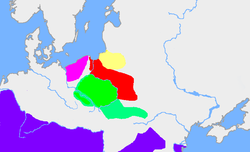Dębczyn culture

The Dębczyn group (in German also Denziner) is an archeological culture in Pomerania from the 3rd to 6th centuries. It was derived from the neighboring Wielbark culture with influences from the Elbe region, and succeeded by migration of West Slavs, the Pomeranian tribes.
In the second half of the third century, the Dębczyn (Denzin) culture (or group) succeeded the Wielbark culture between the Persante and Drage rivers, and a local, not yet classified culture between the lower Oder and Persante rivers. The adjacent areas to the east were uninhabited by this time. Whether the eastern Dębczyn culture replaced or evolved from the Wielbark culture is not yet known, in the western areas, settlement was continuous. The emergence of this group is characterized by an influence of the Vistula region (Wielbark culture), the expansion of the Gustow group, and many paralleles to the Elbe Germanic areas.[1][2][3] The dead were buried unburned. The culture existed until the first quarter of the 6th century, when burial of the dead in grave fields stopped.[2][3]
The Dębczyn group might comprise the archaeological remnants of Tacitus' Lemovii, probably identical with Widsith's Glommas, who are believed to have been the neighbors of the Rugians, a tribe dwelling at the Pomeranian coast before the migration period. Germanic sagas report a battle on the isle of Hiddensee between king Hetel (Hethin, Heodin of the Glommas) and Rugian king Hagen, following the abdication of Hagen's daughter Hilde by Hetel. Yet, there are also other hypotheses about the location of the Lemovii, and that their identification as Glommas, though probable, is not certain.[4]
See also
References
- ^ Karl-Heinz Otto, Humboldt-Universität zu Berlin Institut für Ur- und Frühgeschichte, Ost Universität (Berlin, Humboldt-Universität zu Berlin Institut für Völkerkunde und deutsche Volkskunde, Ethnographisch-archäologische Zeitschrift (EAZ), v.43:no.1-4, Verlag der Wissenschaften, 2002, p.390
- ^ a b Johannes Hoops, Hans-Peter Naumann, Franziska Lanter, Oliver Szokody, Heinrich Beck, Rudolf Simek, Sebastian Brather, Detlev Ellmers, Kurt Schier, Ulrike Sprenger, Else Ebel, Klaus Düwel, Wilhelm Heizmann, Heiko Uecker, Jürgen Udolph, Reallexikon der germanischen Altertumskunde, Walter de Gruyter, p.281, ISBN 3-11-009635-8 [1]
- ^ a b Johannes Hoops, Hans-Peter Naumann, Franziska Lanter, Oliver Szokody, Heinrich Beck, Rudolf Simek, Sebastian Brather, Detlev Ellmers, Kurt Schier, Ulrike Sprenger, Else Ebel, Klaus Düwel, Wilhelm Heizmann, Heiko Uecker, Jürgen Udolph, Reallexikon der germanischen Altertumskunde, Walter de Gruyter, pp.266ff, ISBN 3-11-009635-8 [2]
- ^ Johannes Hoops, Herbert Jankuhn, Heinrich Beck, Rosemarie Muller, Dieter Geuenich, Heiko Steuer, Reallexikon der germanischen Altertumskunde, 2nd edition, Walter de Gruyter, 2001, pp.158,159, ISBN 3-11-016950-9 [3]
